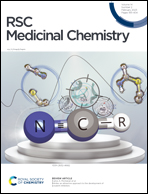Synthesis and properties of the kojic acid dimer and its potential for the treatment of Alzheimer's disease†
Abstract
The kojic acid dimer (KAD) is a metabolite derived from developing cottonseed when contaminated with aflatoxin. The KAD has been shown to exhibit bright greenish-yellow fluorescence, but little else is known about its biological activity. In this study, using kojic acid as a raw material, we developed a four-step synthetic route that achieved the gram-scale preparation of the KAD in approximately 25% total yield. The structure of the KAD was verified by single-crystal X-ray diffraction. The KAD showed good safety in a variety of cells and had a good protective effect in SH-SY5Y cells. At concentrations lower than 50 μM, the KAD was superior to vitamin C in ABTS+ free radical scavenging assay; the KAD resisted the production of reactive oxygen species induced by H2O2 as confirmed by fluorescence microscopy observation and flow cytometry analysis. Notably, the KAD could enhance the superoxide dismutase activity, which might be the mechanism of its antioxidant activity. The KAD also moderately inhibited the deposition of amyloid-β (Aβ) and selectively chelated Cu2+, Zn2+, Fe2+, Fe3+, and Al3+, which are related to the progress of Alzheimer's disease. Based on its good effects in terms of oxidative stress, neuroprotection, inhibition of Aβ deposition, and metal accumulation, the KAD shows potential for the multi-target treatment of Alzheimer's disease.



 Please wait while we load your content...
Please wait while we load your content...